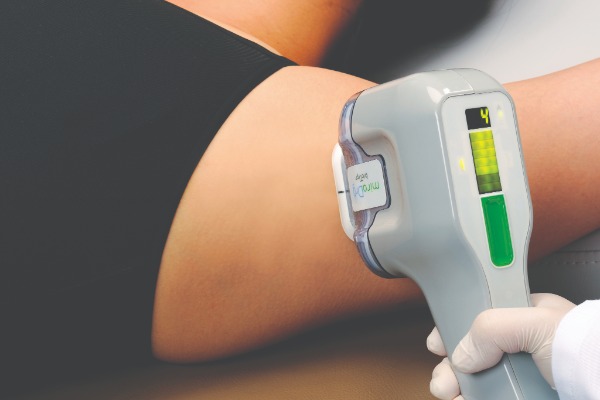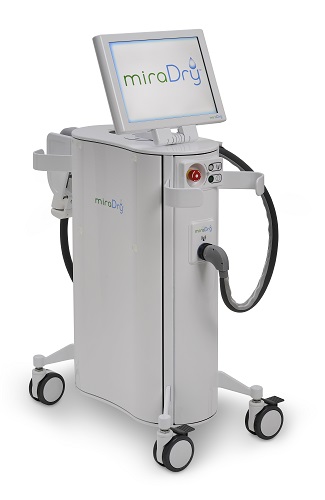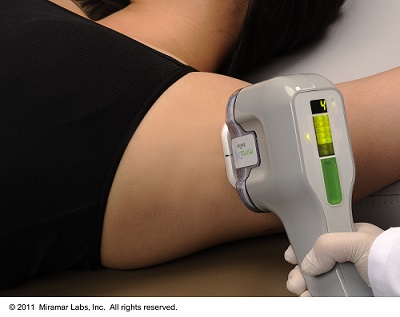
Procedure Time: 60-90 minutes
Recovery Time: Up to 1 week
Results Duration: Permanent reduction in underarm sweating
Cost: Start from approx. £1,995 for a single session.
Anaesthesia: Local anaesthesia
For a full list of FAQs please Click Here.
miraDry is the first and only device cleared by the U.S. FDA for the treatment of excessive underarm sweating or axillary hyperhidrosis. Hyperhidrosis is a medical condition whereby a person has abnormally increased or excessive perspiration or sweating most commonly on the hands, feet, armpits (axillae) and groin area. According to the Hyperhidrosis Support Group, approximately half a million people in the UK are affected with the condition. The device delivers precisely controlled electromagnetic energy to the armpit which heats the sweat glands and destroys them. This results in an immediate and dramatic reduction in underarm sweating. Sweat glands do not grow back, so the treatment is long lasting. In a clinical study, patients experienced an average of 82% reduction in underarm sweat after two treatments. Treatment prices start from approx £1,995 for a single session. Two treatments are generally required, however some people find that one treatment provides an adequate reduction in sweat.
Do you have a question? Ask one of our experts NOWHyperhidrosis is a medical condition whereby a person has abnormally increased or excessive perspiration or sweating, at levels which are more than the body needs to simply regulate temperature.
It can occur on any part of the body, although the most commonly affected sites are the hands, feet, armpits (axillae) and groin area.
Although not a condition which has a serious impact on a person’s health, it can be an embarrassing and distressing condition which disrupts daily life and impacts on a person’s self-esteem.
Hyperhidrosis usually starts in childhood or adolescence and can continue well into adulthood and beyond.
According to the Hyperhidrosis Support Group, approximately half a million people in the UK are affected with the condition.
Treatment options for hyperhidrosis range from special antiperspirants and iontophoresis to botulinum toxin and the more drastic surgical removal of the sweat ducts.
Now, another option using electromagnetic energy has become available.
If you are considering treatment for axillary (underarm) hyperhidrosis, the following information will give you a basic understanding of the procedure. It can't answer all your questions, since a lot depends on the individual patient.
Please ask a practitioner about anything you don't understand.
Excessive underarm sweating can be treated using a device that delivers precisely controlled electromagnetic energy to the armpit.
The energy heats the sweat glands, causing cellular thermolysis which destroys them. This results in an immediate and dramatic reduction in underarm sweat. Sweat glands do not grow back, so the treatment is long lasting.
At the present time, there is only one device available in clinics that uses electromagnetic energy to treat axillary hyperhidrosis, which is called miraDry®.
miraDry is the first and only device cleared by the U.S. FDA for the treatment of excessive underarm sweat. The device has a strong safety record. In a clinical study, patients who were treated using miraDry experienced an average of 82% reduction in underarm sweat after two treatments.
miraDry can only be used to treat axillary (underarm) hyperhidrosis. It is not suitable for use on the hands, feet or groin area.
Raised moles and skin tags must be removed before treatment and the underarm area must be shaved 4 - 6 days prior to treatment.
The first time you visit a clinic, you will need to attend a consultation with the miraDry practitioner in order to assess your suitability for the treatment. The discussion should realistically and clearly highlight your expectations from this treatment.
The practitioner will take a medical history to make sure that there are no reasons why you are not suited to be treated with miraDry. Then you would normally be asked to sign a consent form indicating that you have understood what the treatment may do and any potential side effects.
The practitioner may also do some tests to establish the extent of your hyperhidrosis, such as a starch iodine test, which shows up the levels of sweating. This type of test is not always needed.
The procedure
Before treatment, each axilla is injected with local anaesthetic. A temporary ink template is placed on the armpit, to guide the practitioner during treatment. 
The specially designed miraDry handpiece is placed against the armpit and activated. The skin is pulled towards the treatment head using a vacuum action and the device delivers the energy. The energy is directed to the region where the sweat glands reside and at the same time, the outer layer of the skin is continuously cooled.
After the correct amount of energy has been delivered, the handpiece is moved to the next position on the armpit, using the template for guidance.
The process is controlled by a computer and it takes about 60 - 90 minutes to complete both armpits.
Following treatment, the underarm is immediately iced for 20 minutes.
Repeat treatments
Two treatments spaced at least three months apart are generally recommended, however some patients may find that one treatment provides an adequate reduction in sweat.
You can typically return to work straight after treatment, should you wish to, depending on the type of work that you perform. Strenuous activity should be avoided for a few days.
Some localised soreness or swelling will occur, which means that you may prefer to rest. This typically clears within a few weeks.
It is important to follow any post-treatment advice given to you by your practitioner.
Immediately post-treatment, the treated area is iced in the clinic. This should be carried out at regular intervals, at home, for a few days to reduce swelling, which may last up to 2 weeks.
A non-prescription anti-inflammatory medication such as ibuprofen will reduce the normal inflammation and discomfort that usually occurs immediately after the procedure.
The underarms should be kept clean, avoiding antiperspirant for a few days.
You may also be prescribed an anti-biotic cream to apply to the area, in order to reduce the risk of any post-treatment infection; however not everyone will require this.
Some people have short-term altered sensation in the skin of their underarms or upper arms, which gradually disappears.
A partial reduction or delay in underarm hair growth is a common side effect.
The treatment also eliminates the glands that produce the oily secretion that causes body odour, so a reduction in odour is usually experienced in addition to a dramatic reduction in sweat.
It is worth noting that the concept of compensatory sweating, whereby sweating is increased in other or larger areas of the body post treatment, as can be a common side effect with surgical options to treat hyperhidrosis, is extremely rare in the case of electromagnetic treatment for the condition.
miraDry should not be used on patients who have a heart pacemaker or other electronic device implant or use supplemental oxygen.
If you have previously experienced problems with local anaesthesia (lidocaine with adrenaline) then you should inform the practitioner.
Having a history of botulinum toxin treatment for axillary hyperhidrosis does not mean that you can’t go on to have miraDry. Your practitioner can advise you on any waiting times needed between the two treatments.
miraDry can only be administered by a trained miraDry practitioner.
These are primarily doctors and nurses but may be a fully trained aesthetician working in a clinic which is supervised by a medical team. Your consultation should always be with a doctor or nurse who can diagnose your hyperhidrosis and thus prescribe the miraDry treatment for you if you are a suitable candidate.
Although you will find some treatment options for hyperhidrosis are available through the NHS, the use of electromagnetic treatment as a solution is a private treatment.
Treatment prices start from approximately £1,995 for a single session. Two treatments are generally required (for a total cost of around £2,800); however some patients may find that one treatment provides an adequate reduction in sweat.
Hyperhidrosis is a condition that affects sufferers every day of their life, affecting their self-esteem and in some cases stopping them from participating in activities or life events. Although there are many treatment options now available to treat excessive sweating, particularly in the underarm area, not all are a long term solution for all people, either due to efficacy or cost.
The use of electromagnetic energy with the miraDry device is a safe, clinically proven, American FDA-cleared, non-invasive solution for significantly reducing underarm sweat permanently. The system uses precisely controlled electromagnetic energy, delivered to the axilla through a specially designed
handpiece. The energy penetrates to the level of the sweat glands, which are heated and eliminated.
In a clinical study, patients experienced an average of 82% reduction in underarm sweat after two treatments and because sweat glands do not grow back, the results are long lasting.